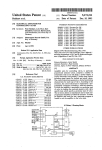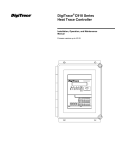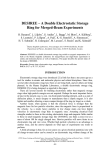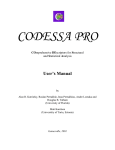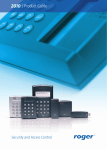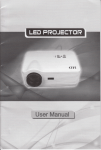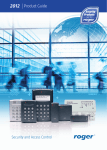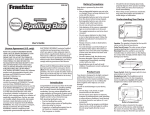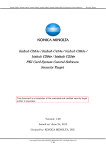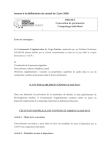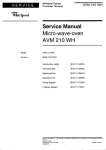Download Small smart distributed control system
Transcript
1976 Proceedings of the 4* World Congress on Intelligent Control and Automation June 10-14, 2002, Shanghai, P.R.China Small Sdart Distributed Control System Yirong Yang and Shanan Zhu Dept. of System Science and Engineering, College of Electrical Engineering Zhejiang University, Hangzhou, P.R. China, 3 10027 E-mail: [email protected] and [email protected] Abstract - This paper presents a small-scale smart distributed control system (DCS) based on RS-485 network. It discusses the network construction of the distributed control system, the characteristics of RS-485, how to 1 interface construct typical RS-485 two wire multi-drop network and the details of the communication protocol. The smart controller based on dual MCUs can execute many kinds of the advanced control algorithms downloaded from the operating station. The controller has strong ability to deal Figure 1. System block diagram with real-time response and great capacity of data processing, because of the dual MCUs structure. The control is stable industrial computer with RS-485 interface or a PC with a and flexible, because the whole program which user has RS232JRS485 converter in the serial port. We select the configured in the operating station is downloaded into RAM. ADC- 106 interface converter made by Atronix, which can The independent watchdog circuit is also designed. transfer the signal transmitting in an RS-232 serial port into the balanced half-duplex RS-485 signal. There is also I. INTRODUCTION an RS-485 interface which adopts MAX485 transceiver made by MAXIM Corporation in each basic controller. Distributed control system (DCS) is a very useful advanced automation device, but its price is very high. Although the DCS manufacturers in the world produce 111. COMMUNICATION SYSTEM Elements of the Communication Network different kinds of small scale DCSs, the system is also expensive to the small enterprises in the developing The data transmission of the whole system is in an country. To meet the needs of the small enterprises, we RS-485 system. Fig. 2 is an example of a typical RS-485 design a small-scale smart distributed control system which is cost-effective. RS-485 is as follows: 11. SYSTEM ARCHITECTURE two wire multi-drop network. The characteristics of The speed of RS-485 bus is quick and the maxim speed is 1OMbps. The whole system includes a PC or an IPC and several basic controllers. The PC as the operating station is used The distance of the bus is long. For example it can transmit data for 1200 meters by the speed of 9OKbps. to configure h c t i o n blocks and monitor the control It has the strong ability to eliminate common mode process. Basic controller equipped with double CPUs is disturbance, because each signal is transmitted in a used to sample data and execute control algorithms. The balanced data transmission system. communication system adopts EINTIA-485 Standard Each generator or dnver can drive up to 32 which is represented by RS-485. The above elements constitute the small scale DCS. The system architecture is receivers. shown in Figure 1. The operating station can be an ~ 0-7803-7268-9/01/$10.00 02001 IEEE. Authorized licensed use limited to: UNIVERSITY OF PLYMOUTH. Downloaded on September 21, 2009 at 10:13 from IEEE Xplore. Restrictions apply. June 10-14, 2002, Shanghai, P.R.China Proceedings of the 4* World Congress on Intelligent Control and Automation 1977 Network CommunicationProtocol The communication system between the PC and the LJ- . controllers is strictly the master-slave type system in broadcasting mode. The slave nodes are not permitted to transmit data without a request from the master, and do not communicate with each other. The communication Figure. 2 Typical RS-485 two wire multi-drop network Because of the above advantages, RS-485 is always between the slave nodes is not direct. The message must firstly be stored into the master node, and then be chosen to transmit data in the industrial field control forwarded to another slave node. Each slave must have a system. When construct an RS-485 network, it is unique address so that it can be addressed independent of necessary to have a termination match the impedance of a node to the impedance of the transmission line being used. other nodes. The baud rate is 9600bps. The data frame consists of ten bits: a start bit (0), eight data bits (LSB When those impedances are not matched, the transmitted signal is not completely absorbed by the load and a first), and a stop bit (1). The data is in package form, and the format of the package is shown in Table I.PC (or IPC) portion of it is reflected back into the transmission line. broadcasts the address of the controller to be connected, The method to terminate data !ines is to add a resistor in and all controllers receive the address at the same time. parallel with the receiver A and B lines in order to match Then each controller will compare the received address the data line characteristic impedance specified by the with its own address. If the address of the controller is the cable manufacture (120Q is a common value). ADC-106 RS-232 to RS-485 converter is made by Atronix Inc. The same as the received address, the controller is connected and the other controllers are isolated from the network. converter can be plug into RS-232C serial port of standard And now the network includes only the master node and DB9 pins and be supplied power by TXD, DTR and,RTS signals. The power voltage must be more than 5v. The the connected slave node so they can communicate with each other. The communication program flow chart is network interface of the basic controller is MAX485, shown in Figure 4. which is low-power transceiver for RS-485. Controlling the COMS chip is very simple. Driver Enable (DE) and IV. DESIGN OF SMART CONTROLLER Receiver Enable (RE) pins are included on MAX485. Usually, one of the output ports of the controller is The basic controller is the core of the hardware and the connected to both DE and RE pins. When the logic of the software of the whole control system. Whether the design port is low, the serial port is in the state of receiving. If of it is good or not will influence the usability, stability, sending the data, the output port logic must be made high. and the ability of real-time response of the DCS. To meet the needs of the real-time response and the handling of The typical operating circuit is shown in Figure 3. TABLE I The format of the data package Sour- Destinat ce adder Leng Cont -ion -th of -ent address pack of a-ge. pack -ss ;I' age DI DE ROm Dl LE How two two two N bytes bytes bytes bytes Figure. 3 Typical operating circuit of MAX485 Authorized licensed use limited to: UNIVERSITY OF PLYMOUTH. Downloaded on September 21, 2009 at 10:13 from IEEE Xplore. Restrictions apply. bytes byte 2978 June 10-14, 2002, Shanghai, P.R.China Proceedings of the 4' World Congress on Intelligent Control and Automation data in large quantity, we design a smart controller Disable interrupt, based on double MCUs. One MCU deals .with data save PSW sampling and real-time control, and the other deals with data transmission. The data exchange between the two CPUs is through the dual-ram (IDT7132). There are 8 analog input channels, 6 analog output channels( including 2 PWM channels). 16 digital input channels. 16 digital output channels. and 2 pulse input channels. Its block diagram is shown in Figure 5. The master CPU deals with data sampling and signal processing and receives the If the destinationaddress IS the configuring program downloaded by the operating station. Because the program downloaded form the PC executes in RAM, the control of the system is very flexible. The controller can execute advanced control algorithms. And the functions of modifying parameters on-line and giving If right ? an alarm can be included also. Therefore the controller can +I be made smart. The slave CPU is used for communication. It can receive the message from the operating station and YES Send error message then send the message to the master CPU. If the master According to the control bytes, which PC need send CPU sends data to the PC, it must send the data to the send affirming message. again. Figure.4 Flaw chart of communicationp'ogram RS-485 8OC 196KC Dual- 80C 196KC interface slave CPU RAM master Analog Interface Figure. 5 Block diagram of the smart controller Authorized licensed use limited to: UNIVERSITY OF PLYMOUTH. Downloaded on September 21, 2009 at 10:13 from IEEE Xplore. Restrictions apply. Proceedings of the 4* World Congress on Intelligent Control and Automation V. CONCLUSIONS From above discussion, it is clear that the controller has these advantages. [2] [ 11 Michael Babb, “Distributed Process Control System Integrates hocess Design and Control”, Control Engineering, vo1.32, no. 12, [3] RS-422 and RS-485 Application Note, B&B Electronics Mfg. Co. Inc, October 1997 [4] Guo Moufa“and Wang Shaobo, “The Design of RS-485 Network and Its Applications in Industrial Monitoring Systems”, Journal Of Fuzhou Universtity,Vo1.27, No. 1, 1999 EORGE J. BLICKLEY, “Distributed Control Systems: New and Improved at ISA/85”, Control Engineering, 2979 November 1985, pp.81 *The watchdog circuit (h4AX705) is independent, which can not only monitor the executing program but also monitor the power-supply. The circuit significantly improves system stability. VI. REFERENCES Shanghai, P.R.China vo1.32, no.9 September 1985, pp150-152 *The controller has good perfonnances because of its dual-CPU structure. *The controller is flexible, because the whole program is downloaded from the operating station. June 10-14, 2002, [SI 8x196kk-d User$ Manual, Intel Inc. 1992 Authorized licensed use limited to: UNIVERSITY OF PLYMOUTH. Downloaded on September 21, 2009 at 10:13 from IEEE Xplore. Restrictions apply.




